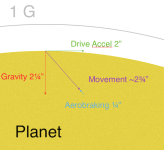but the same argument is just as valid for streamlined lift.
PROVE IT.
Cite the RAW which states that starship streamlining adds aerodynamic lifting force.
Extra bonus points if you can cite a reference that mentions a stall speed for starships (preferably for each streamlined configuration code, or are they all the same?).
I'm not the one claiming that starships get AERODYNAMIC LIFT FORCE "for free" in atmospheres just by virtue of being streamlined.
You are.
Once you can substantiate your
claim that streamlining = free lift force ... preferably with a citation of RAW ... we can talk.
Until then, you've got nothing but assumption powering your assertion.
I'm pointedly NOT relying on Lift Force to add an additional vector "assist for free" in atmosphere.
If anything, I'm taking the more "universal" approach to the problem that doesn't rely on aerodynamic lift to make starships "go up" in a gravity well.
Or to put it another way, I'm going for the "harder lift" on being able to get to orbit.
The benefit of my approach is that it relies on No External Forces Added beyond what the maneuver drive can deliver in terms of acceleration force (regardless of how that force is engineered). Relying "purely" on the maneuver drive means that in all cases where manevuer G is greater than gravity G (with atmospheric drag being added to gravity G) means that regardless of atmosphere type, your Starship can liftoff and accelerate towards orbit.
Why does that argument not apply to a craft sliding along the surface of the imaginary surface of the planet until the Horizontal vector is greater than the Vertical vector in the Vector Movement rules?
Seriously?

Your maths is wrong because you are making incorrect assumptions. You keep assuming Traveller ships are rockets.
NO.
I am assuming that Traveller starships move under maneuver drive according to Newtonian Physics as expressed by acceleration vector movement.
1G vector "foward" plus 1G vector "aft" = 0G net vector acceleration
1G vector "up" plus 1G vector "down" = 0G net vector acceleration
In order for ANY object (not just starships) to ascend in altitude while inside a gravity well, their net acceleration vector "up" needs to exceed the (gravity) acceleration "down" in order to gain altitude.
If UP exceeds DOWN ... then you go UP (towards orbit).
If DOWN equals or exceeds UP ... you're staying DOWN (on the surface) or descending towards the surface (until making contact with something).
In a Traveller starship, all acceleration force(s) are produced by the maneuver drive in CT.
What orientation the starship takes is immaterial (tail sitter, belly lander, inverted barrel roller, whatever).
To make an object GO UP ... it needs an acceleration force applied to it that is exceeds the local gravity field.
That's not just "rocket science" ... that's bare bones BASIC PHYSICS ... and I'm embarrassed that I even have to explain this (again!).
This is why I say that 1G maneuver drive minus 1G of gravity well means 0G net acceleration in the UP direction ... which means
You Are Not Going To Space Today™.
However, a 2G maneuver drive minus 1G of gravity well means 1G of net acceleration in the UP direction ... meaning ... You Go To Space.
That's just the way that acceleration vectors work with Newtonian Physics.
You are never going to convince me with your "rather unique posting style" and my arguments are not going to convince you.
"Never argue with a man whose job depends on not being convinced."
-
Upton Sinclair
You refuse to see the OBVIOUS point:
Yeah ... we're done here.
When someone is unwilling to concede that 1-1=0 ...
Was it the design intent of the Game Creator that these ships and the players in them would be unable to land on 1/6 of the worlds they encountered [including EARTH]
{ speaking slowly and patiently }
That's. What. Orbital. Shuttle. Services. Are. For.
That's. Why. Small. Craft. With. High. Acceleration. Are. Useful. For. Surface. To. Orbit. Transfers.




